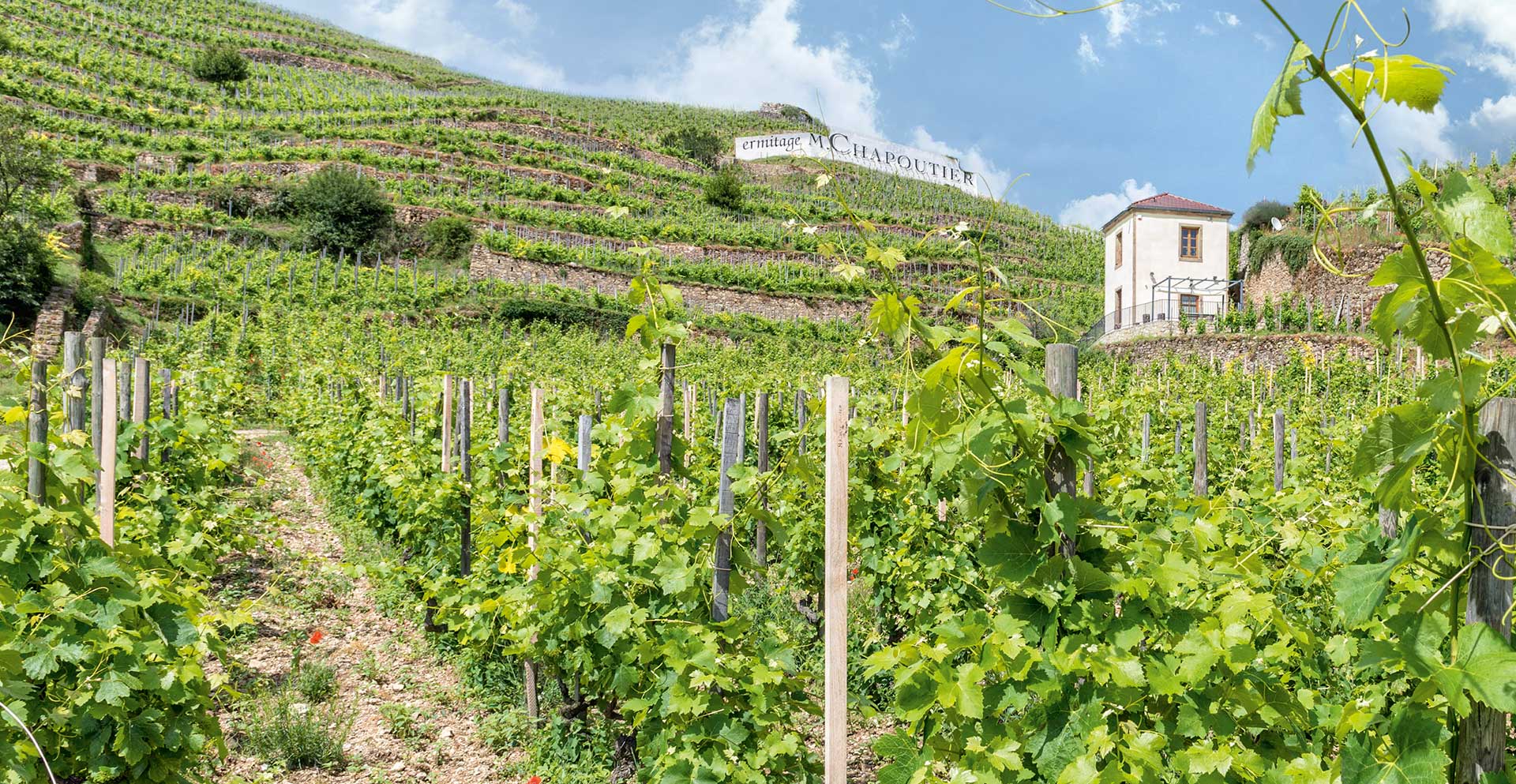The 2020 harvest in the Rhône Valley: when precocity signs great wines
In the vineyard
09 February 2021
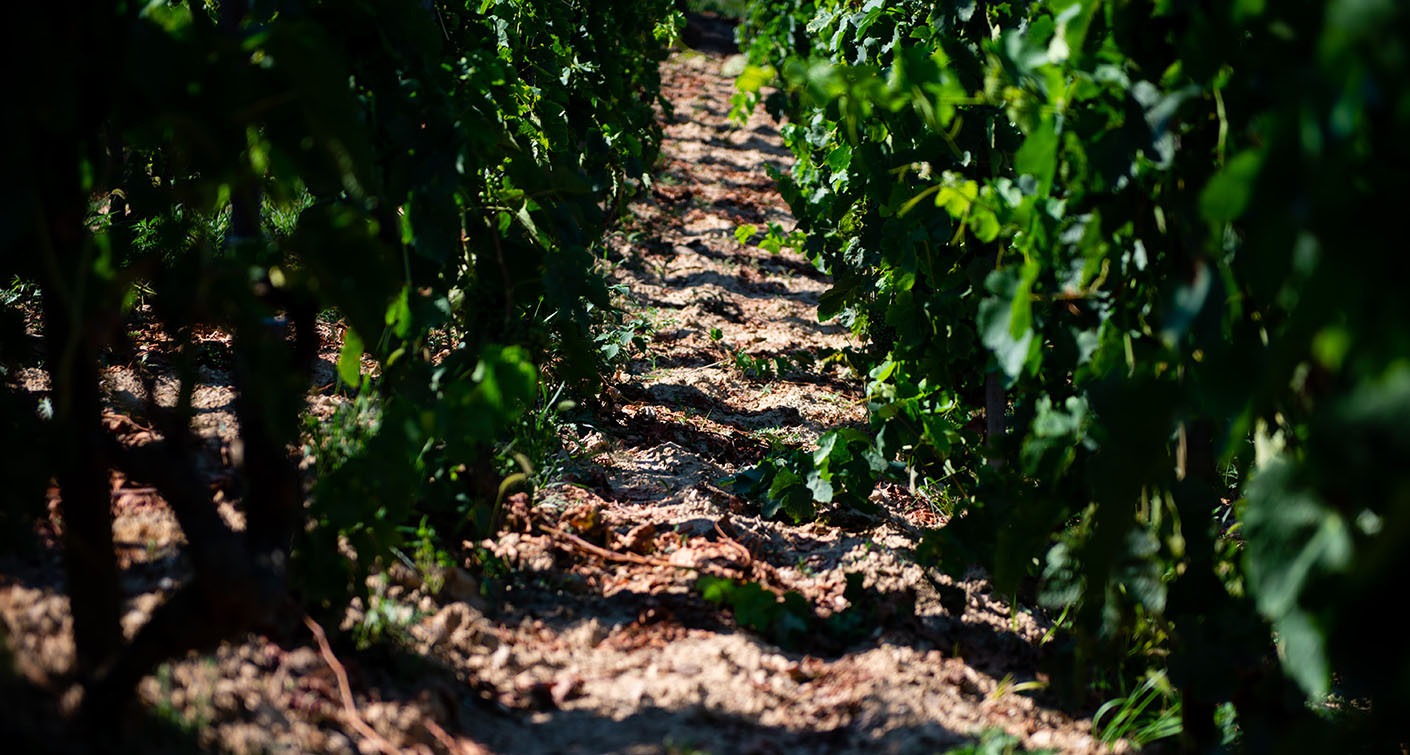
Early harvests are the hallmark of great wines
2020 will undoubtedly stand out as an atypical leap year.
The season started mild, with temperatures reaching 10°, helping us to put winter behind us. The first effects of this mildness were the onset of grass growth on the plains of Crozes-Hermitage, bringing bright colours to the landscape. While pruning progressed on the slopes, in mid-February, the almond trees start to flower, about ten days ahead of schedule. Pruning wounds were treated to protect them from disease. Very soon, the first signs of vine leakage began, announcing its awakening. The winter was mild, marked by a water shortage over the period but reserves had built up at the end of 2019 (more than 500mm in all).
In mid-March, the buds begin to shake and come out of their cotton, heralding the onset of a speedy sequence of events. At the end of March, the first leaves spread, the budburst came early, 10 days earlier than the previous year... Life came back to the vines with the appearance of the first insects, the first flowers and a few bud-eaters that feed on the Bessards while the urban landscape went into hiding. A completely different setting awaited us at sunrise on March 26th on Domaine Les Granges de Mirabel, with an unexpected but stunning carpet of snow.
The absence of a real winter made spring frosts a threat, and on April 1st, the temperature plummeted to -2°C, burning a few young leaves and buds on the Beaumont Monteux plains. The landscape’s spring metamorphosis came with poppies dotted amongst the vines, splashing colour on the hillside canvas. On Domaine Les Granges de Mirabel, intense sunlight in April and May accelerated vine growth. The diversity of organisms between the rows of vines brought the landscape to life. Bud pruning was barely over when the vines needed the help of the supporting wires. Horn silica (Preparation 501) was exactly what we needed at that moment.
At the end of April, inflorescences were clearly visible on both sides of the northern Rhône Valley appellations. Branches reached for the sky. And finally the first heavy rains arrived, and with it, thunderstorms. May’s rainfall (more than 100mm) combined with the rise in temperature boosted plant growth. Green work could begin on the vines, with a first and quickly a second tying-up campaign, whilst flowering was in full swing on the Hermitage and Saint-Joseph, in an ideal climate. The Le Méal flowerhoods were already jumping off the newly-formed berries.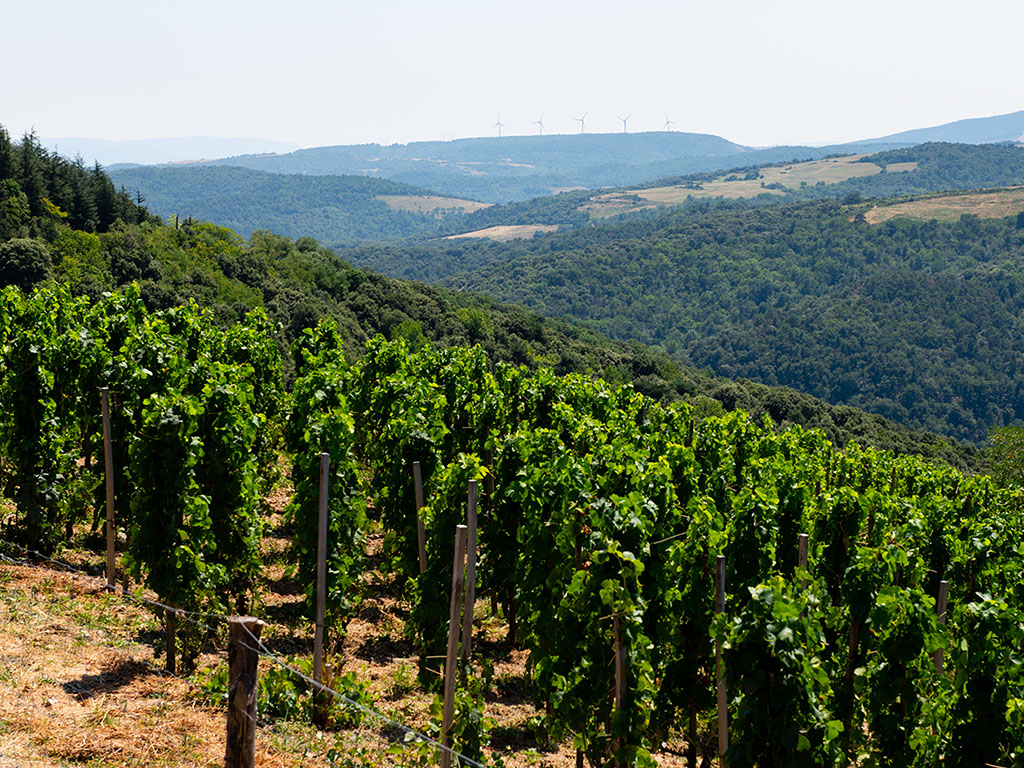
Calculations had to be done in double-quick time, showing that we could expect an earlier vintage than in previous years... Even on the heights of Saint-Péray in Payrolles, the vines were ahead of schedule. Of course, we had to adapt to the pandemic, learn all about infection prevention and control measures, reorganise the teams so that everything could operate properly during lockdown. Of course, it is the vine that sets the pace, and the pace was fast! A world of contrasts...
While June started without cryptogrammic pressure thanks to a dry summer climate, in the Southern Rhône Valley, the rains were a welcome prelude to summer. They brought a few outbreaks of mildew on the flowers in the Gard but Vaucluse and notably Châteauneuf-du-Pape, were spared. And the Grenache “hung on” as the saying goes, without any run-off, guaranteeing a good harvest.
The bunches continued to grow during June, but a few hailstones fell on Combe Pilate, at a time of year when the berries are fragile, the season yet young. The wounds healed quickly and continued the process of repair through the summer, actually loosening the berry in a perfectly natural way. At the end of June, on Châteauneuf-du-Pape, the Grenache grapes were splendid and so different to 2019 when the successive waves of heat had marked them so. And already, veraison was under way on l’Hermitage in the first week of July, amazingly spreading to all the sectors, from Pavillon to Greffieux, erasing the usual discrepancies between foothill, slope and orientation.
In mid-July, hail battered Chasse-sur-Rhône, but spared Côte-Rôtie. The healing herbal mixtures and the run-off water helped the leaves regenerate fairly quickly. Overall, veraison was late. On Côte Brune (La Mordorée) veraison also got under way, really early. But Ampuis felt the heat, and in places the leaves were showing the effects of the lack of water (barely 320mm since January).
At the end of July, temperatures had been high for several days, although not to the same extent as 2019, but without rain. The young vines were vines developed normally. One thing is certain, the harvest would be early, but we were ready. Because of the preparations required because of the pandemic for the harvest period, it was important to be able to harvest at the right time, and we had to get the balance right. We considered different scenarios to ensure we got could get the harvest in satisfactorily.
At Domaine Les Granges de Mirabel, under the scorching sun of the last weeks of July and the first week of August, chamomile matricaria and stinging nettle infusion sprays helped the Viognier bunches to ripen properly, without suffering from the lack of water.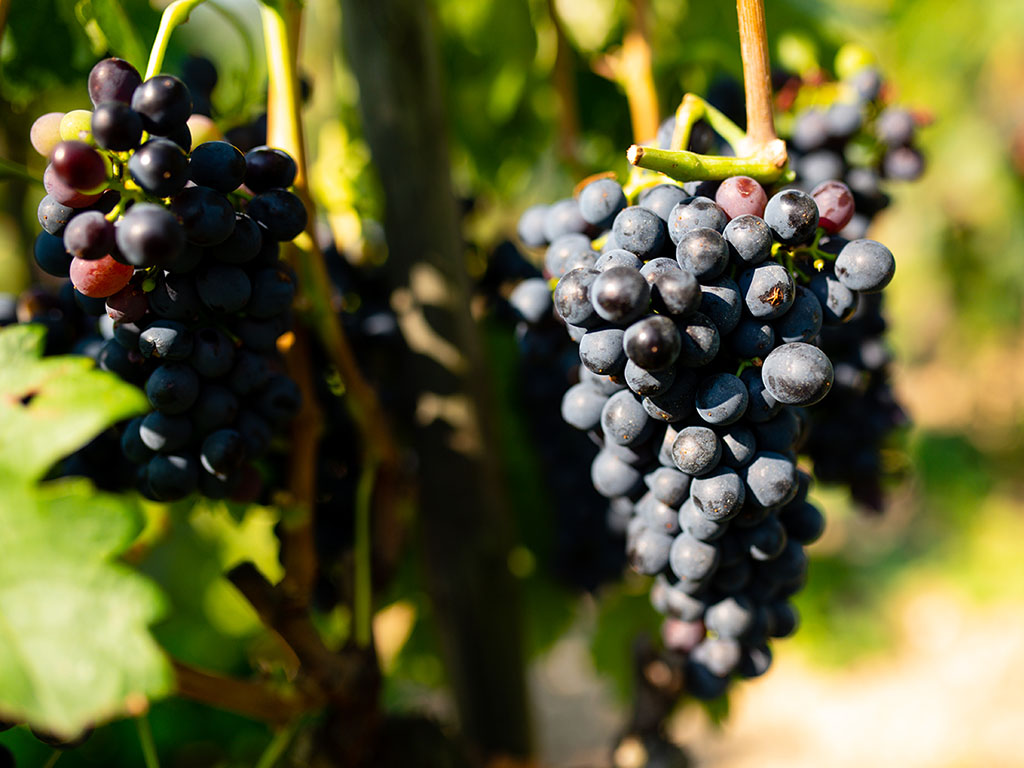
In mid-August, Hermitage hill changed; quite a spectacle, revealing patches affected by hydric stress. The Marsanne grapes were already gilding well. It was early days, but the berries seemed to be well advanced. Initial analyses confirmed it. The picking teams were called in to start earlier than expected, knocking off a few days of the holiday period. Patrols of the plots confirmed our belief that there would be a fairly quick start to the harvest, similar to what we remember from 2003. There were some signs of scalding on Crozes-Hermitage, and we all feared the worst should the rains fail to show up.
On August 19th, as the sun cast its first rays on Chante-Alouette, a final briefing was given on infection prevention and control measures at the top of the Méal and we set about this very particular 2020 harvest with Le Méal white. The first juices were promising with acidity retained in spite of the heat – a consequence of the absence of rain and temperatures that concentrated the acidity instead of burning it. We continued harvesting the whites on the hillsides of Saint-Joseph (Les Granits) and Les Murets (De L’Orée). Just like in 2015, L’Ermite white was early and we picked on the top of the hill on August 25th. The next day, the first reds were brought in: Le Méal then Les Greffieux and the first Saint-Joseph with Le Clos and the Saint-Joseph hillside. From there, the pace was sustained, with beautiful days and cooler nights that kept the temperature under control. On August 27th, very unusually and somewhat worryingly because of the early harvest dates, we brought in the first Côte-Rôtie with Neve. We went to Condrieu to pick the Coteau de Chery, and in the meantime most of the whites had been brought in to preserve their sugar/ acidity balance.
On Friday August 28th, the rain finally came, easing the plots that were still holding back. The red grapes were picked over a period of a fortnight or so. The Mordorée came in as early as September 3rd, when we started harvesting the first Shiraz on Châteauneuf-du-Pape, not quite as early as expected. On September 4th, Le Pavillon was harvested with exceptional, very black berries, tasting simply perfect with excellent phenolic maturity, supported by a nice acidity. We were impatient to get a first Taste after the first wine had been drawn off, and then a few weeks later at the end of Vinification. The next day we picked Varogne (Les Varonniers) which had benefited from Hermitage’s cooling shade. It looked promising there as well. On Wednesday September 9th, we brought in L’Ermite off the hill. At Domaine Les Granges de Mirabel, the harvest ended up being not as early as that, taking place on September 5th and 6th, revealing the superb Quality of the grapes harvested. The first juices tasted were fresh and well-balanced, promising a fine vintage for Viognier de Mirabel.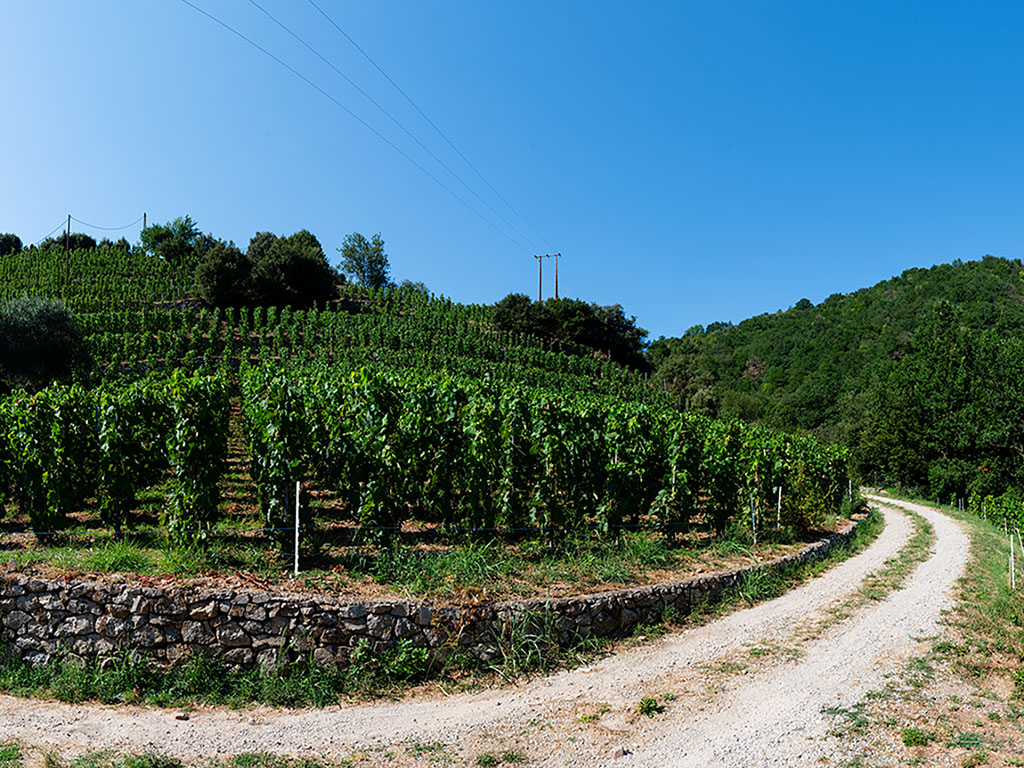
By September 10th, the harvest was well under way... compared to other years when it would only just have begun by then. The first Grenache grapes from Châteauneuf-du-Pape came into the cellar, with good balance and very nice fruit, a result of their not being excessive sunshine. The season was calm and without cryptogrammic pressure, but the famous Cevennes rains were forecast in the south. The picking teams were reinforced to speed up the harvest and bring in Croix de Bois and Barbe Rac just ahead of the rains to keep their potential intact.
The harvest ended on September 18th with the Cornas de Saint-Pierre in the Northern Rhône Valley. We had to wait to harvest the last Châteauneufdu- Pape plots until September 26th. Truly, we saw what can only be described as a wondrous climatic inversion for this 2020 vintage! Marked by exceptional earliness and scorching mid-summer heat, the 2020 vintage offers us wines full of elegance and pedigree, far from the excesses we might have expected. They have all the markers of great ageing potential because preserved acidity and remarkable phenolic maturity. The elegance of the red wines and the expression of minerality supported by a beautiful acidity on the whites are the hallmarks of this particular vintage that is full of surprises.
Our favourites
Ermitage Le Pavillon red
With its deep black colour, Le Pavillon expresses intense notes of graphite and wild fruit coulis upon entry. Then follows a rush of notes of violet, noble spices and hot stone. The palate is straightforward, the tannins draped with a rare nobility. The finish is flavoursome, with incredible persistence on notes of black pepper and cold smoke.
Ermitage De l’Orée white
With its light gold colour with aniseed reflections, De l’Orée offers us at first glance fine notes of yellow fruits and honeysuckle. After swirling the wine in the glass, the bouquet becomes more empyreumatic, with hints of grilled corn, salted butterscotch and sweet spices. The finely-textured palate is full and tonic at the same time, giving way to a salty finish with delicate aniseed nuances.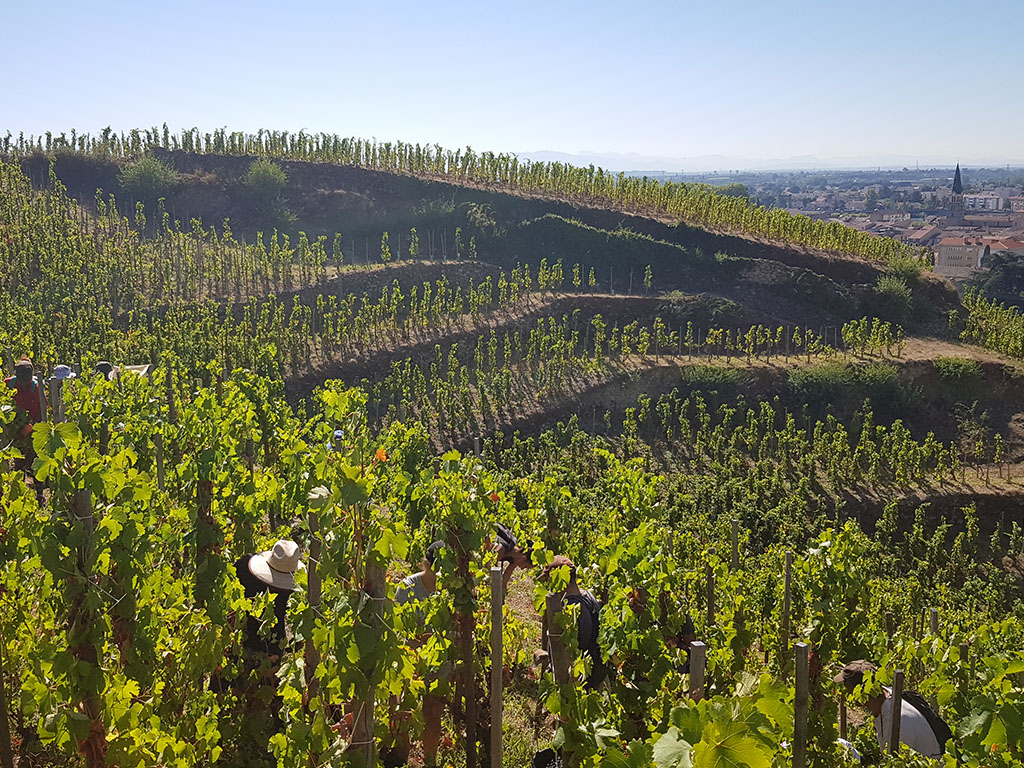
Wine-tasting comments
Croix de Bois red: bewitching nose of crushed raspberry and orange zest. The preserved freshness offers us a delicate, finely draped mouth, with a hint of rose water.
Barbe Rac red: racy, spicy, with hints of ripe black fruits and a touch of laurel. In the mouth, the attack brings tonic tannins, and the finish a hint of cocoa, then graphite, black olive. The lingering, acidic finish gives a nice nuance to its athletic structure.
La Mordorée red: intense nose where black fruits and bacon dominate. Fresh and delicate on the palate with silky tannins. A complex bouquet of spices, musk, olive and violet. Long, flavoursome finish.
Côte-Rôtie Neve red: an explosion of black fruit coulis, bramble leaf and black pepper, illustrating superb aromatic freshness. The attack is juicy, the mouth dense, chiselled and mouth-watering. A lingering finish with blueberry and floral notes of cornflower. One of the outstanding wines of the vintage.
Le Clos red: a very expressive nose with hints of blueberry, graphite and bitumen. The attack on the palate is powerful, with tannins of great nobility. Complex finish with hints of sweet spices.
Les Granits red: intense fruit nose, violet, black pepper and an empyreumatic touch make this wine already brilliant. The still tightlypacked palate is both dense and elegant. The finish is full of spicy and full-bodied nuances.
Les Varonniers red: the ripe, juicy fruits combine with the pedigree of this great terroir and its meatier nuances. Tapenade, graphite and smoky notes complete a bouquet of great scope. On the palate, the tannins are soft and lush, the finish mouth-watering.
Les Greffieux red: nice, ripe fruit, a touch of blueberry underscored by mocha notes. A beautifully full attack in the mouth, with refreshing tannins on the finish. A remarkable synthesis of concentration and freshness.
Le Méal red: deep nose with scents of blackberry coulis, spices, and something slightly smoky. Ample attack, smooth tannins, but mouthwatering on the palate. A perfect illustration of what balance should mean.
L’Ermite red: floral nose, bramble leaf, graphite, small red fruits… the list is endless. A vertical wine, with a flavoursome, chiselled mouth. Exceptional length on notes of peony and cold smoke.
Le Pavillon red: with its deep black colour, Le Pavillon expresses intense notes of graphite and wild fruit coulis upon entry. Then follows a rush of notes of violet, noble spices and hot stone. The palate is straightforward, the tannins draped with a rare nobility. The finish is flavoursome, with incredible persistence on notes of black pepper and cold smoke.
Les Granits white: an initial nose of clashing pebbles and a hint of match-head, yellow-flesh fruits, slightly roasted. The velvety attack introduces a flavoursome, easily-digestible mouth: a purified version of the vintage with great potential.
De l’Orée white: with its light gold colour with aniseed reflections, De l’Orée offers us at first glance fine notes of yellow fruits and honeysuckle. After swirling the wine in the glass, the bouquet becomes more empyreumatic, with hints of grilled corn, salted butterscotch and sweet spices. The finely-textured palate is full and tonic at the same time, giving way to a salty finish with delicate aniseed nuances.
Le Méal white: explosive nose of fresh quince and white flowers. When swirled in the glass, the typical notes of smoke and tomato leaves emerge. Creamy but digestible and mineral on the palate. A lingering finish of sweet spices and crystallised fruit.
L’Ermite white: a still-shy nose with hints of honeysuckle and lemon zest. After breathing, toasty and stony notes invade the glass. The palate is refined, with a real haute couture feel. A wine for the purist, with immense potential.


